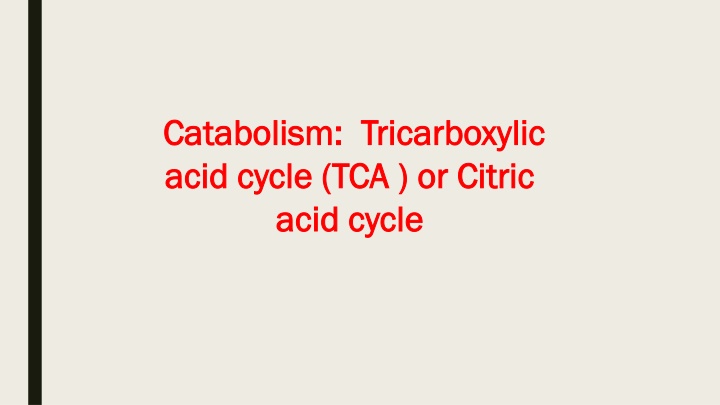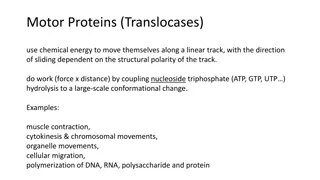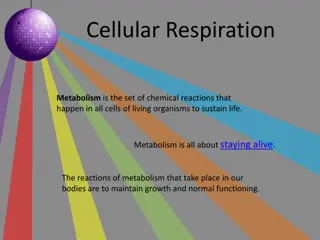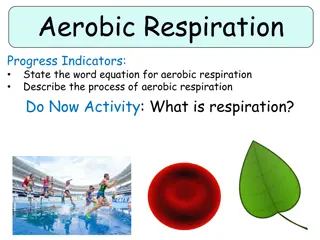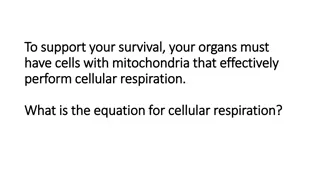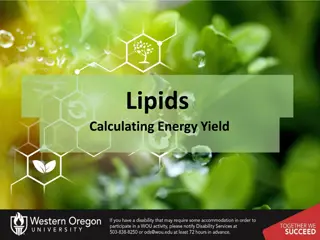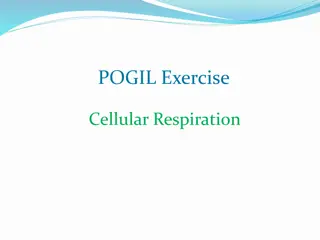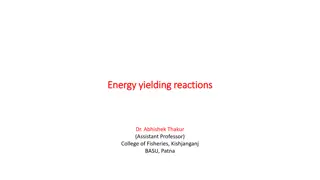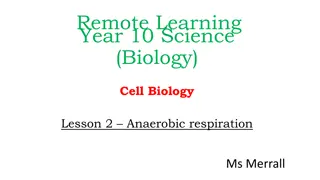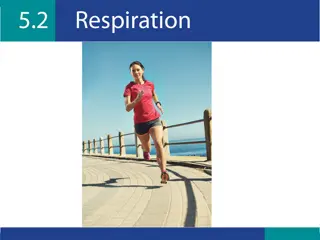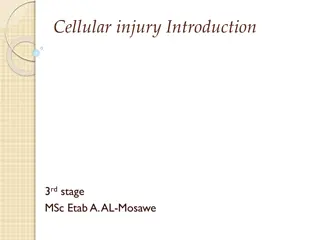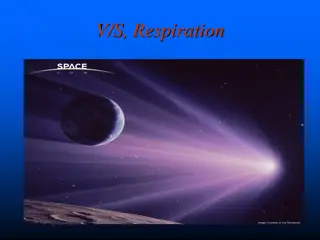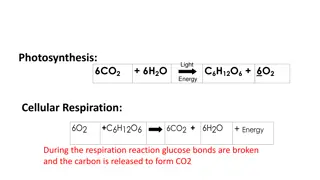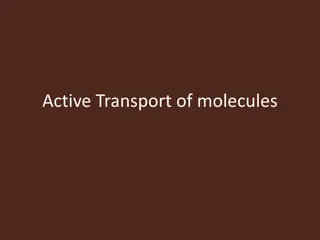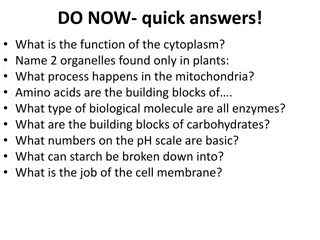Overview of Cellular Respiration Pathways and ATP Generation
Cellular respiration involves key processes like the Tricarboxylic Acid Cycle (TCA), Electron Transport Chain, and ATP generation pathways. The TCA cycle utilizes Acetyl-CoA to produce energy-rich molecules, while the Electron Transport Chain facilitates ATP synthesis through oxidative phosphorylation. These pathways collectively yield a significant amount of ATP from the aerobic oxidation of glucose, supporting various cellular functions and biosynthesis.
Uploaded on Jul 23, 2024 | 2 Views
Download Presentation

Please find below an Image/Link to download the presentation.
The content on the website is provided AS IS for your information and personal use only. It may not be sold, licensed, or shared on other websites without obtaining consent from the author.If you encounter any issues during the download, it is possible that the publisher has removed the file from their server.
You are allowed to download the files provided on this website for personal or commercial use, subject to the condition that they are used lawfully. All files are the property of their respective owners.
The content on the website is provided AS IS for your information and personal use only. It may not be sold, licensed, or shared on other websites without obtaining consent from the author.
E N D
Presentation Transcript
Catabolism: Catabolism: Tricarboxylic acid cycle (TCA ) or Citric acid cycle (TCA ) or Citric acid cycle acid cycle Tricarboxylic
Krebs cycle (TCA): Acetyle CoA is the substrate of this cycle, it arises from the catabolism of many carbohydrates, lipids and amino acids. It is an energy-rich molecule composed of coenzyme A and acetic acid joined by a high energy thiolester bond..
TCA cycle generates : 2 CO2s ,3 NADHs ,1 FADH2 ,1 GTP for each acetyl CoA molecule oxidized . The cycle enzymes are widely distributed among M.O. The complete cycle is functional in many aerobic bacteria, the facultative anaerobes does not use the full TCA cycle under anaerobic conditions, this cycle is an important source of energy and provide carbon skeleton for use in biosynthesis. Only 4ATP molecules is directly synthesized when 1 glucose molecules is oxidized to 6 CO2 molecules by glycolysis and TCA cycle. Most ATP generated comes from the oxidation of NADH and FADH2 in the electron transport chain.
The electron Transport Chain Mitochondrial electron transport chain is composed of a series of electron carriers that operate together to transfer electrons from donors, like NADH and FADH2 to acceptors such as O2. The electrons flow from carriers with more negative reduction potentials to those with more positive potentials and combine with O2 and H+ to form water. The electron transport chain carriers located in the inner membrane of the mitochondria or in the bacterial plasma membrane. The process by which energy from electron transport is used to make ATP is called oxidative phosphorylation .
ATP yield from the aerobic oxidation of glucose Glycolytic pathway Substrate- level phosphorylation (ATP) 2 ATP Oxidative phosphorylation with 2NADH 4-6 ATP 2 pyruvate to 2 Acetyle CoA Oxidative phosphorylation with 2 NADH 6 ATP Tricarboxylic Acid Cycle Substrat level phosphorylation (GTP) 2 ATP Oxidative phosphorylation with 6NADH 18 ATP Oxidative phosphorylation with 2FADH2 4ATP ------------------------------------------------------------------------- ------- Total Aerobic Yield 36-38 ATP
Aerobic respiration is much more effective than anaerobic processes that not involving electron transport and oxidative phosphorylation. Many M.O when moved from anaerobic conditions to aerobic conditions will reduce their rate of sugar catabolism and switch to aerobic respiration this phenomenon known as Pasteur effect; this is of advantage to the M.O as less sugar must be degraded to obtain the same amount of ATP when the more efficient aerobic process can be employed.
Anaerobic Respiration Many bacteria have electron transport chains that can operate with exogenous electron acceptors other than O2. The major electron acceptors are nitrate , sulfate and CO2 but metals and a few organic molecules can also be reduced.
Some bacteria can use nitrate as the electron acceptor at the end of their electron transport chain and still produce ATP, this process is called dissimilatory nitrate reduction. Nitrate may be reduced to nitrite by nitrate reductase : NO3 +2e NO3 +2e- - + 2H NO2 +H2O + 2H NO2 +H2O However ,this is not effective way of making ATP, because the large amount of nitrate is required for growth a nitrate molecule will accept only two electrons, the nitrite formed is also toxic.
. therefore nitrate is further reduced to nitrogen gas this process known as de-nitrification NO3 NO2 NO N2O N2 Denitrification is carried out by some bacteria like Paracoccus denitrificans , Pseudomonas and Bacillus
Some bacteria Methanogenes use CO2 or carbonate as a terminal electron acceptor, they reduce CO2 to methane. Sulfate (SO4) also can act as the final acceptor in bacteria such as Desulfovibrio ,it is reduced to sulfide (S2 or H2S) and eight electrons are accepted.
Lipid Catabolism Microorganisms use lipids as energy sources. Triglycerides or triacylglycerols, esters of glycerol and fatty acids are common energy sources. They can be hydrolyzed to glycerol and fatty acids by microbial lipases ,the glycerol is then phosphorylated ,oxidized to dihydroxyacetone phosphate and catabolized in the glycolytic pathway.
Fatty acids from triacylglycerols and other lipids are oxidized in the oxidation pathway after conversion to coenzyme A esters ,fatty acids are degraded to acetyl-CoA , which can be fed into the TCA cycle or used in biosynthesis ,the cycle also produces acetyl- CoA, NADH and FADH2 ; NADH and FADH2 can be oxidized by the electron transport chain to provide more ATP . Lipid fatty acids are a rich source of energy for microbial growth.
Protein and Amino Acid Catabolism Some pathogenic bacteria, fungi,food spoilage and soil microorganisms can use proteins as their source of carbon and energy. They secrete protease enzymes that hydrolyze proteins and polypeptides to amino acids which are transported into the cell and catabolized.
Deamination: first step in amino acid use it is the removal of the amino group from an amino acid and transferred from an amino acid to an -keto acid acceptor, the organic acid resulting from deamination can be converted to pyruvate ,acetyl CoA ,or a TCA cycle intermediate and oxidized in the TCA cycle to release energy ,it is also can be used as a source of carbon for the synthesis of cell components .Excess nitrogen from de-amination may be excreted as ammonium ion ,thus making the medium alkaline.
References References 1. Microbial Physiology. Albert G Moat, John W Foster, Michael P. Spector. 2002. Fourth Edition. A John Wiley and sons, INC., publication. 2. Microbiology. Lansing M Prescott, John P. Harley, Donald A. Klein.2004. Sixth Edition. Higher Education. 3. Microbial an introduction. 2004. Gerard J Tortora, Berdell R Funke, Christine L Case. Eighth Edition.
